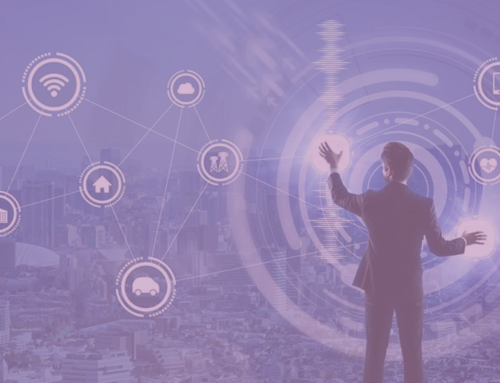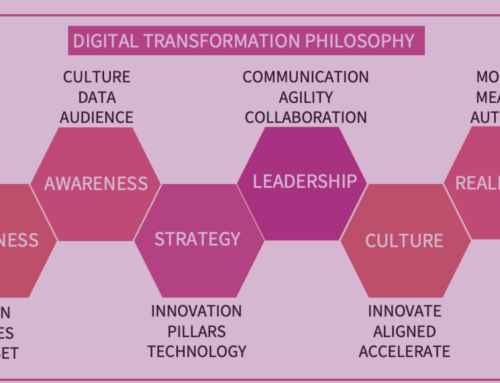As a digital leader planning or implementing a digital transformation programme, you’ll be looking at many aspects of what drives transformational change.
I’ve been looking at aspects of organisational change recently, and talking to many digital leaders about some of the most important things they’ve learned. Something that’s really clear is how business agility, and embracing and driving transparency are vital traits of successful transformational leadership.
If you’re looking to build a more agile business through your transformational programme, one important aspect of the organisation that may need to change is the culture. In fact, the success or otherwise, or your change programme is very likely to depend on the organisational culture.
In this article, I’m going to look at four steps to achieving business agility, and consider an important tool for embedding cultural change – employee experience platforms.
First, let’s look at the four steps that make up a digital cultural framework.

Thinking about this framework in the context of driving change raises a number of questions:
- Communication – one of the clear challenges of remote working is effective communication. How, as a digital leader, driving cultural change, do you ensure that your key messages are being received, engaged with and acted on? How will you drive a more agile organisation and encourage collaboration between a dispersed workforce?
- Customer-centricity – one of the key aspects of an agile organisation is its understanding of customer need (which drives innovation and change). How can you analyse and monitor your employees’ understanding of how their own role (which may not be a traditional ‘customer-facing’ role) impacts on your customers?
- Employee action – how accountable are individual employees? With many traditional managerial styles being broken down by remote working, how will you ensure team members are fully engaged in your change programme? Without physically being able to work together, how will you drive collaboration, innovation and autonomy across the organisation?
- Speed and performance – how to you access, analyse and share data in real-time, to promote agile attitudes to change?
There is no single answer or solution to these questions, but one tool that is becoming increasingly dominant among forward-thinking, agile businesses is the Employee Experience Platform.
Enter the Employee Experience Platform (EXP)
Several years ago, we had intranets – internal websites focussed on providing information to company employees.
EXPs are a new generation of intranet, driven by the recognised need to keep people connected across an organisation – and have become particularly relevant since Covid enforced a move to more remote working.
Although many organisations had the functional side of operations in place to allow people to work effectively from home (and those that didn’t swiftly changed that), what quickly became obvious was that there were some big challenges when it came to managing culture and engagement remotely.
Attitudes towards communication needed to change, to take into account the need for human connection, and digital technology was at the heart of that. EXPs are now seen as invaluable business tools for engaging employees and supporting their overall experience.
But what is an EXP?
Essentially, an EXP is a platform that lets you treat your employees more like customers. It offers advanced communications, networking and knowledge-sharing, as well as information.
Unily, an EXP provider working with major global corporations including Shell, identifies 5 main front-end features that set EXPs apart from a traditional intranet.
1. Enhanced communications experience
As we’ve already seen, ensuring effective communications is a vital first step in achieving business agility, and in a remote-working age, this becomes even more critical. How to manage the sheer volume of communications is a challenge for many organisations. How can we ensure our employees are receiving and responding to relevant communications, and not ‘switching off’ due to overwhelm?
An EXP has a role to place in improving internal communications through treating them in a similar way to customer communications- highly targeted, consistent across a range of media touchpoints and devices, and offering choices for interactivity.
2. Social connectivity
EXPs are designed to closely mimic the conversations and exchanges of ideas that would naturally take place in an office environment. Taken those interactions into a digital environment allows not only the actions familiar from social media (eg liking and commenting), but deeper responses and actions. Employees can create digital identities within the EXP, build work networks and communities and achieve recognition and gamified rewards. The aim is to create a collaborative platform and virtual community, rather than the ‘traditional’ intranet one-way communication.
3. Integrated search uniting knowledge
Our expectations have changed. We expect to be able to search easily, Google-like, by typing keywords and finding instant answers without having to sift through reams of irrelevant information. An EXP gives you the opportunity to integrate with your other knowledge management and storage systems and provide an intuitive search experience.
4. Single point of access
An EXP can provide a singly access point to all your organisation’s apps, tools and data, effectively overcoming the tendency to create information silos, and saving your employees time. Instead of searching multiple platforms for the tools and information they need, everything is accessible through one gateway – your EXP. It keeps the experience consistent, frictionless and straightforward, removing many of the frustrations associated with remote working.
5. Cross-device accessibility
Just as today’s consumers expect any time, anywhere access, now your employees can expect and benefit from the same. At the very least, an EXP allows you to tailor and optimise access for any device, uniting your employees in a single, digital space. But a good EXP will also provide the option for branded mobile apps and targeted mobile experiences.
To see an example of this in practice, take a look at Unily’s Shell case study.
Offering these front-end user experiences requires certain ‘back-office’ components. The technology framework sitting ‘under the hood’ is what will give your EXP flexibility and longevity. As a basic framework, you should look for:
- An intuitive CMS allowing flexible publishing and administration features, enabling targeted content and experience and ensuring the right people get the right messages, at the right time.
- AI, used intelligently. You may already be using sophisticated AI functions in your consumer communications. Your EXP should be able to mirror this – for example through automated media processing.
- Effective analytics. Once again, you already analyse your customer data. With an EXP you have the opportunity to gain real understanding of how your employees are really experiencing work. This is likely to take the focus away from traditional productivity measures like time/task, and more towards looking user behaviour. How are your employees searching for, and finding your content? What media do people in different roles prefer? Are they engaging with your key communications?
- Futureproofing through agility. Your EXP platform will need to have digital agility at its core, with the ability to adapt rapidly to changing needs, probably through pre-built ‘plug-and-play’ features that can be added simply and quickly.
Finally, when looking for an EXP solution, look for an active community of users, a peer group who share ideas, experience and solutions to challenges, with access to training guides, webinars, events and feedback.
Effectively implementing an EXP can help you to build, change or develop your company culture, no matter how remote your workforce, how different their needs or access preferences or what their device preferences.
Returning to my point at the beginning of this article, if you are a digital leader involved in transformation change, one key way to drive the cultural change that will help you to achieve the outcomes you need is through putting a futureproof EXP in place.
Ready to produce game-changing digital results in your business?
Subscribe to receive cutting edge insights on digital leadership and transformation- straight to your inbox
We do not sell or share your information with anyone.









